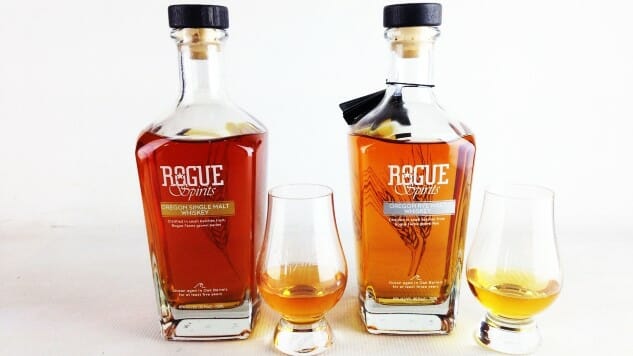Rogue Spirits: Tasting Oregon Single Malt and Rye Whiskeys
Photo by Jim Vorel
Microdistilling ain’t easy, and the truth of the matter is that it will never be easy. Even as spirits continue to enjoy dynamic growth and more drinkers develop palates nuanced in American bourbon and rye, it doesn’t really make the job of a small distillery much easier. They’re never going to be able to compete with the larger producers in terms of the premiumization they can give their products. Simply put, you’re not going to make a better 20-year bourbon than someone at Beam or Heaven Hill, because you’ll never have 20 years to catch up with their development. Nor will you be able to compete with those same distilleries on a price point for a two or four-year whiskey.
The obvious alternative is to innovate and produce spirits with specific flavor profiles that aren’t serviced by the titans of this industry—but in doing so, you run the risk of making products that are too “out there” to find a niche among drinkers who want more of the same. I can only imagine that this is maddening to people who dump new spirits into barrels, hoping a market will exist for them a few years later.
The reality is that this tends to make for some middling whiskeys while microdistilleries slowly figure things out. Oregon’s Rogue Spirits, better known for the craft brewery side of the equation, might be considered a poster child for that kind of slow evolution. They’ve been in the spirits game for much longer than most at 14 years, not always to the excitement of drinkers. In particular, their early whiskey releases had a degree of notoriety around them for the lack of age on the liquid—some bottles were sold after aging for only a few months. It was unclear if “time” and practice could simply be a cure-all for all of Rogue’s spirits, but it was something that certainly needed refinement.
Now, that patience is beginning to bear fruit. Rogue’s newest whiskey releases range from two years to five years in age, and we’re pleased to report that all of them have benefited. In particular, we’re focusing today on the 3-year-old Oregon Rye Whiskey and the 5-year-old Oregon Single Malt Whiskey.
Rogue Spirits Oregon Rye Whiskey
The American consumer has more or less been trained at this point to expect a specific profile out of bottles with “rye whiskey” on the label, likely due to the prevalence of MGP of Indiana juice in so many different, seemingly separate rye brands. Rogue’s three-year Oregon Rye Whiskey diverges greatly from this profile, but much of that has to do with the rye grain itself—this is a malted rye whiskey, which are not commercially common. Rather than the “spicy rye bread” profile that is typically contributed by unmalted rye, the malted variation has more in common with malted barley—which is also found in this whiskey in abundance. The results are a bit unusual, and make me wonder why they wouldn’t call it something like “malted rye whiskey” on the bottle.
On the nose, Oregon Rye Whiskey is floral, malty and honey-sweet, with a fresh grassy note and overall profile that makes me think of many approachable Irish whiskys. There’s a doughiness to the grain/malt profile, without specifically evoking the more expected spice of rye. Apple fruitiness combines with mild caramelization for a pleasant “caramel apple” quality, chased by a sweetness that is almost butterscotch-like. Light notes of clovey spice round everything out.
-

-

-

-

-

-

-

-

-

-

-

-

-

-

-

-

-

-

-

-

-

-

-

-

-

-

-

-

-

-

-

-

-

-

-

-

-

-

-

-








































